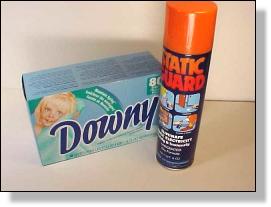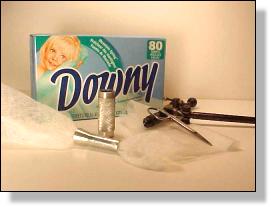In the northern climes the season for being on stream is over
for this year and our dreams are focused in the hopes of an
early spring.
As we sit in quiet contemplation of the year past we are aglow
like an ember in the fireplace with the warmth of recollection
created by many wonderful days gone by.
Many of us, and particularly those who read this column regularly,
are able to extend our enjoyment of a delightful hobby by tying
the flies we will use for catching fish next year.
How delightful is this wonderful game we call flyfishing!
Unfortunately all is not "delightful" or "wonderful" indoors.
With the cold weather comes the necessity to heat our homes.
indows are buttoned up tighter than Scrooge's purse, the humidity
is akin to that of the Mojave Desert, and the only time you have
seen more static is when you put that fresh bird skin in with
your wife's mixed vegetables!
Deer hair is a particular offender when it comes to static.
Maybe instead of building nuclear power plants we should
have just gotten a few deer hooked up to some wires and
told them to rub their butts together. [editors note, this is not be taken
literally, it is humor. We do not condone abuse of deer.]
It's funny how some things sneak into fly tying. A commercial
some years ago showed a woman wearing a dress that was well
rumpled with the offending static. She didn't run around in a fret,
she just reached for her magic can of "Static Guard", a spray
of which tamed the unsightly mess allowing her to go about her
business.
Yes, you too can use "Static Guard" to spray your deer hair,
if you want. But, there is an easier, less messy solution to
your deer hair static problems, and it is absolutely 100% free.
You just can't get any cheaper than that!
Next time you or your wife removes your clothes from the dryer,
take that little "fabric softener" sheet you threw in with your
wet clothes to your tying bench.

The "used" sheet is important as both the Static Guard and new
fabric softener sheets leave a definite smell behind, and no
doubt a good dose of residue on your deer hair, or what ever
material they contact.
The used sheets on the other hand have had the aromatic quality
largely dissipated in the dryer as they do their job of making
our clothes nice and soft, and almost wrinkle free. I am convinced,
however, that the brand I use comes with few wrinkles already in
the box, which get all over my clothes as they sit for days
waiting for me to come home from fishing to retrieve them
from the dryer.
If you will take the used sheet and gently rub it with the grain
of your deer hair, you will get rid of a part of the static.
Now grab your hair stacker, take a corner of the sheet and making
a point slip it through the center of the tube. Next, using the
same point, swab out the inside of the barrel of the stacker.

OK two down two more to go.
Carefully dab your double edge razor blade with your sheet.
Almost got the whole thing licked, three down, two left to go. Bet
you thought I couldn't count too!
Take the sheet and wipe the jaws of your vise.
Now fold the sheet neatly into quarters, place it on your bench
and lay your scissors onto it. Every time you set them down,
place them back onto the sheet.
Now, go ahead and tie away. You will get a lot of spinning and
trimming done with very little annoying static. If it starts to
rebuild it's insidious charges, simply wipe the offending article
as before and go back to tying.
This same technique works on things other than deer hair, or the
tools mentioned, though the hair is infamous for creating static
electricity.
The next time the mother in law gives you a bunch of static, you
know what to do!
If you have any tips or techniques, send them along, most of this
material has been stolen from somebody, might as well steal your ideas
too!~ George E. Emanuel
(Chat Room Host Muddler)
|





